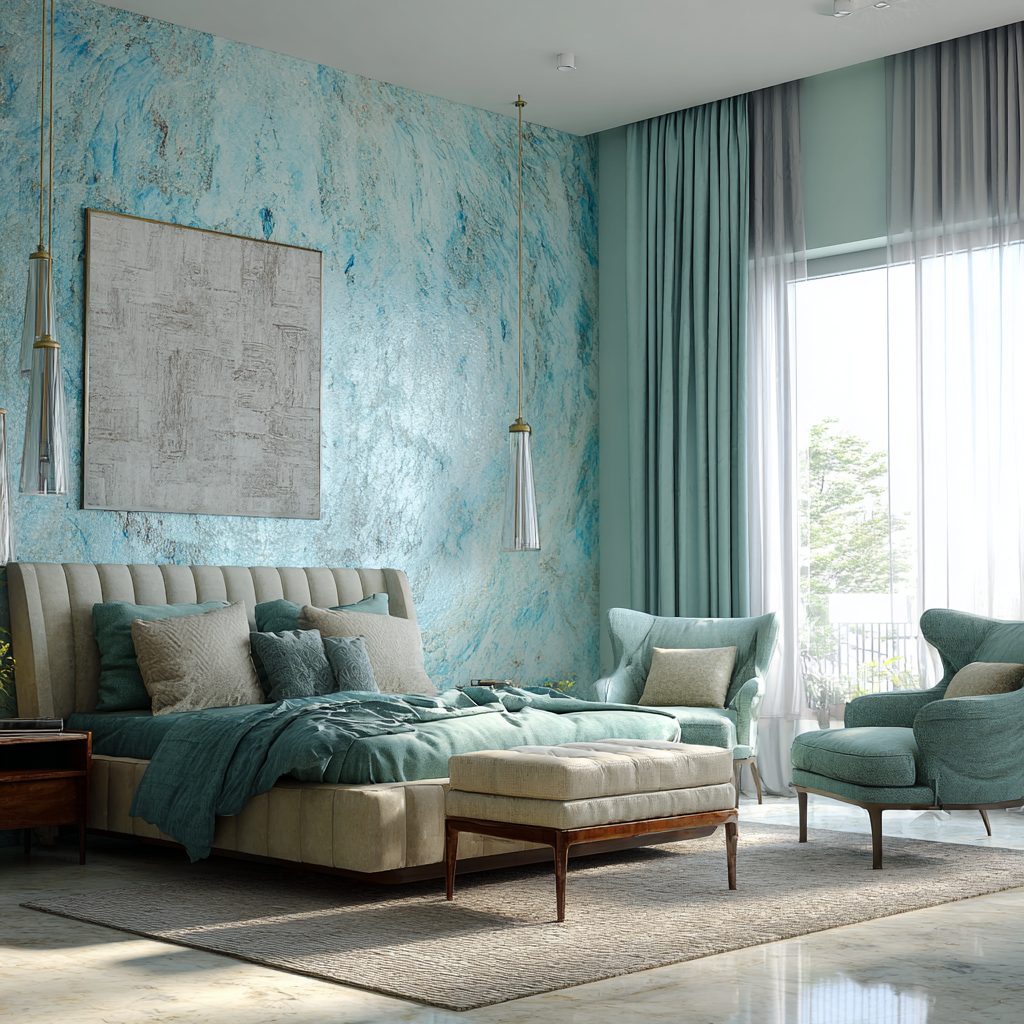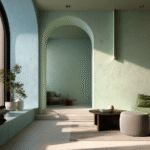Why Choose Marmorino Plaster Vs. Other Wall Plasters? Our Marmorino Toronto Contractors Share Secrets
By: Marcrete Concrete Contractors Toronto
When it comes to wall finishes that exude elegance, texture, and timeless beauty, few materials rival Marmorino.
Originating from ancient Venetian architecture, this lime-based plaster has re-emerged as a top choice among designers and homeowners seeking a natural, luxurious finish.
But what truly sets Marmorino apart from other plaster options like Venetian, Tadelakt, or Microcement? Let’s get right into it!
What Is Marmorino Plaster?
Marmorino is a traditional lime plaster enriched with marble dust and natural minerals. It dates back to ancient Rome but gained global recognition in the Renaissance, when Venetian architects used it to emulate stone walls without adding weight.
Today, Marmorino continues to captivate modern designers for its smooth, stone-like texture, durability, and eco-friendly qualities.
Unlike synthetic wall coatings, Marmorino breathes allowing moisture to escape rather than trapping it.
This makes it ideal for humid climates and interior spaces where air quality matters. It also offers a distinctive visual softness that pairs beautifully with both classical and minimalist interiors.
Comparing Common Plaster Finishes
Before we explore what makes Marmorino unique, it’s important to understand how it differs from other popular plaster finishes.
Venetian Plaster: Known for its mirror-like sheen, Venetian plaster can be synthetic or lime-based. It delivers a glossy, marble-like finish but is less breathable than Marmorino.
Tadelakt: A Moroccan lime plaster famous for its waterproof properties, Tadelakt is often used in bathrooms, spas, and hammams. It has a soapy, smooth texture but requires regular waxing to maintain water resistance.
Microcement: A modern, thin coating made from cement, polymers, and pigments. It’s incredibly versatile for both walls and floors but tends to feel colder and more industrial than natural plasters.
Gypsum and Clay Plaster: Commonly used in budget projects, these options are simple to apply but lack the aesthetic depth and longevity of lime-based plasters.
Each finish has its strengths, but Marmorino offers a rare balance of beauty, performance, and sustainability.
What Sets Marmorino Apart From Other Plasters
Marmorino stands out for its composition and finish quality. It’s entirely natural, composed of hydrated lime, marble dust, and mineral pigments, making it VOC-free and non-toxic.
Beyond its eco credentials, Marmorino creates visual depth thanks to the crystalline texture of marble particles that subtly reflect light.
According to LimeWorks US, lime plasters like Marmorino can absorb up to 33% of their weight in CO₂ during curing. This carbon recapture process makes it a sustainable building material that literally helps purify indoor air while hardening.
In terms of texture, Marmorino provides both matte and satin finishes, depending on the polishing technique. It’s also highly customizable in colour, with endless natural and pigmented tones that integrate seamlessly with architectural lighting.

Design Versatility And Aesthetic Value
From luxury condos in Toronto to minimalist lofts in Vancouver, Marmorino’s versatility makes it a designer favourite. It can mimic stone, marble, or even clouds, depending on the artisan’s technique.
Its natural light reflectivity adds dimension and warmth to interiors, perfect for creating statement walls, curved features, or entire spaces with organic movement.
Marmorino pairs well with wood, metal, and concrete, blending seamlessly into contemporary and classical spaces alike. It’s often used in commercial design, from boutique hotels to restaurants, where tactile surfaces evoke luxury and craftsmanship.
Durability And Maintenance Comparison
When it comes to longevity, Marmorino outperforms most plaster types. Its mineral composition makes it naturally resistant to mould and humidity. Compared to gypsum, which can crack or discolour over time, Marmorino maintains its beauty for decades when properly applied.
While Tadelakt offers superior waterproofing for wet zones, Marmorino’s breathable protection helps regulate moisture and prevent condensation. Microcement, though durable, can develop hairline cracks if applied over unstable substrates.
With Marmorino, flexibility in lime allows minor structural movement without visible damage.
A professionally applied Marmorino finish can last 15 to 25 years or more, making it a long-term investment that actually improves with age.
Eco-Friendliness And Sustainability
In a world moving toward sustainable building materials, Marmorino shines. It’s free from synthetic resins and chemical additives, emits virtually no VOCs, and even helps reduce carbon in the air during curing.
Its ingredients, lime and marble dust, are sourced from nature and recyclable at end of life.
Furthermore, the plaster’s ability to “breathe” prevents trapped moisture, improving indoor air quality. As Canadian builders increasingly pursue LEED-certified and Net Zero designs, Marmorino fits seamlessly into eco-conscious architecture.
Cost And Value Considerations
Marmorino is considered a premium finish, and rightly so. In Canada, professional applications typically range from $15 to $25 per square foot, depending on texture and complexity.
While Venetian or Microcement finishes may cost slightly less, Marmorino’s superior longevity and timeless appeal make it a worthwhile investment.
Beyond numbers, the value lies in perception. Homes featuring hand-trowelled Marmorino walls often command higher resale appeal due to their artisanal craftsmanship and natural beauty.
Installation Process And Expertise
Applying Marmorino is both an art and a science. Skilled artisans apply multiple thin layers of plaster, compressing and polishing each one to achieve the desired depth and sheen. The process may take several days to allow curing between coats.
DIY enthusiasts can attempt small areas, but large-scale projects demand professional craftsmanship. The result is a bespoke surface that feels alive — subtle variations, soft gradients, and tactile warmth unmatched by synthetic coatings.
Conclusion
Marmorino isn’t just another wall finish, it’s a statement of taste, craftsmanship, and sustainability. Unlike synthetic coatings or common gypsum plasters, Marmorino’s natural composition and artisanal application make every surface unique.
Whether used in residential sanctuaries or commercial showpieces, it remains one of the most refined finishes available today.
If you’re seeking a timeless, breathable, and eco-friendly wall finish that stands apart, Marmorino might just be your masterpiece.
If you have any questions about our article, “Why Choose Marmorino Plaster Vs. Other Wall Plasters? Our Marmorino Toronto Contractors Share Secrets” or need a marmorino contractor near Toronto, contact us at info@marcrete.ca or connect with us on social media.
Frequently Asked Questions
What Is Marmorino Made Of?
Marmorino is made from hydrated lime, marble dust, and natural pigments, resulting in a durable, breathable, and eco-friendly finish.
Is Marmorino Waterproof?
Marmorino is moisture-resistant but not fully waterproof. It’s breathable, making it ideal for walls in humid rooms but less so for direct water exposure.
How Long Does Marmorino Last?
With proper application and care, Marmorino can last over 20 years while maintaining its texture and colour.
Can Marmorino Be Applied Over Drywall?
Yes, as long as the drywall is properly primed with a mineral-based base coat to ensure adhesion.
Is Marmorino Expensive?
It’s more expensive than paint or basic plaster, but its longevity, natural look, and low maintenance justify the cost.
What Colours Are Available In Marmorino?
It comes in a wide range of natural and tinted shades, from soft whites and greys to deep earth tones and metallic finishes.
Is Marmorino Environmentally Friendly?
Yes, it’s one of the most sustainable plaster types, emitting little to no VOCs and even absorbing CO₂ during curing.
How Is Marmorino Different From Venetian Plaster?
Marmorino offers a softer, more matte texture compared to the high-gloss finish of Venetian plaster, and it’s generally thicker and more breathable.
Can Marmorino Be Used Outdoors In Canada?
Yes, but it requires specific sealers and professional application to withstand Canada’s freeze-thaw cycles.
Does Marmorino Add Value To A Home?
Absolutely. It enhances visual appeal, improves indoor air quality, and adds a handcrafted touch that attracts buyers seeking premium finishes.







